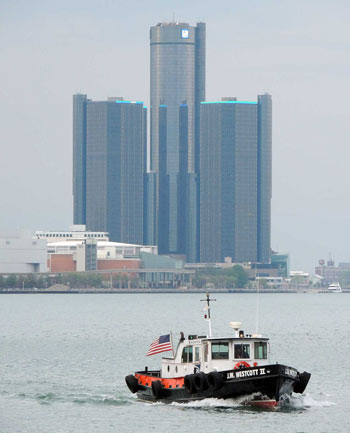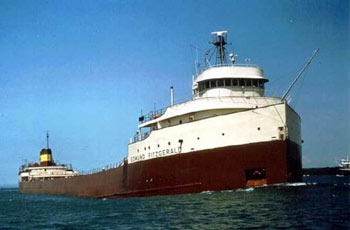The Only Floating Zip Code
by Mike Crowe

The J.W. Westcott II mail boat at work in the Detroit River across from the General Motors building. The 45' steel vessel has delivered U.S. mail, cargo and pilots on the Great Lakes since 1949. The company is open 24 hours a day, 7 days a week, and has been in business since 1874.
The only floating zip code in the United States is 48222. It is aboard the J.W. Westcott II, a 45' X 4' 6" X 9' steel vessel built in 1949, which is the official U.S. Postal Service mailboat servicing the Great Lakes. The vessel is owned by the J.W. Westcott Company and operated from their Detroit, Michigan, wharf on the Detroit River between Lake Erie and Lake St. Claire.
The J.W. Westcott Company has delivered the United States mail since 1948. The company was founded in 1874 when its function was vessel reporting, telling companies and the families of sailors, in the days before radio communication, where their ships were at any given time. The company also delivers cargo to freighters transiting the Great Lakes between Lake Ontario and Lake Superior. They provide pilots, to international freighters, who guide ships through canals, locks, shoal waters and the sudden changes in weather conditions characteristic of the largest group of freshwater lakes on Earth, containing 21% of the world’s surface fresh water by volume. Freighters enter the St. Lawrence River and Seaway from the Atlantic Ocean and cross Lake Ontario. Just west of the Niagara River on the Canadian side, they enter the Welland Ship Canal, which parallels the river. They travel south through 8 locks to Lake Erie, thereby avoiding the 160-foot-high Niagara Falls.
J.W. Westcott descendant and current president Jim Hogan said they “supply ships with whatever provisions freighter crews need, from groceries to bar soap.” The company can deliver anything from a one-ounce letter to huge replacement engine heads for freighters to a donkey they once delivered from Marquette to Detroit, Michigan. The J.W. Westcott Company has said USPS mail service would not be sustainable without the company’s cargo and piloting revenues, with revenues about evenly divided among the three services. The company makes about 16 deliveries in its 24-hour workday, 7 days a week.
Hogan was in his second season at the company when the Edmund Fitzgerald sank in 36 fathoms, in 35-foot seas and 90 mph winds in November 1975. The Fitzgerald was the largest ship on the Great Lakes when it was built in 1958. Hogan said storms are most common on the Great Lakes in early November. The storm that sank the Fitzgerald was a double-barreled low, said Hogan—two storms coming together, which developed cyclonic winds, not unlike the so-called perfect storm that occurred on Nov. 1, 1991, when three storms collided off New England, generating 100-foot seas and sinking several fishing boats.
Most of the mail service and cargo transfers take place on the Detroit River within an hour of the Westcott wharf. Time is money for big freighters loaded with valuable cargos traveling from Lake Superior to the east. These ships remain underway at about 10 mph when the 45' Westcott comes alongside to reach for the bucket suspended on a rope from the freighter above, to deposit the U.S. mail or other cargo that will be hauled aboard.
The service J.W. Westcott provides is one of many unique arrangements that can be traced back to the goals of Benjamin Franklin when he established the USPS in 1775 to connect and inform the citizens about their new nation in it’s formative years. JW Westcott’s might be the most unique of postal service contracts, as it provides service to citizens away from home and land for months at a time.
Freighter crews on Great Lakes ships are onboard for 90 days and off for 30 days. Freighters change crews at the J.W. Westcott wharf on the Detroit River. The J.W. Westcott runs from April 1st until the river freezes over or on Dec. 20th.

SS Edmund Fitzgerald, 903', was an American Great Lakes freighter that sank in a Lake Superior storm on November 10, 1975, with the loss of the entire crew of 29. When launched on June 7, 1958, she was the largest ship on North America’s Great Lakes, and she remains the largest to have sunk there. As a “workhorse,” she set seasonal haul records six times, often breaking her own previous record. The sinking led to changes in Great Lakes shipping regulations and practices that included mandatory survival suits, depth finders, positioning systems, increased freeboard, and more frequent inspection of vessels.
Jim Hogan recalled 1970 when the USPS, in a cost-cutting move, attempted to end the postal service on the Great Lakes. Jim Hogan’s father ran the company at the time. He called the company’s many customers—the sailors, their families, ship companies, suppliers—and got a huge supportive response. He also needed the support of several Michigan congressmen, lawyers and citizens to call for continued mail service on the Great Lakes. After a long and expensive effort, the contract was restored. Hogan said J.W. Westcott has come a long way since that era. He thinks the kind of service that J.W. Westcott provides under the conditions it provides it is graphic evidence of what the USPS can and does do.
